As a reseller, pricing items for sale is the backbone of your business. It is a delicate skill and art to price your item appropriately.
You don't want to price too high and scare away potential buyers. However, you also don't want to price too low because the ultimate goal is to make a profit.
In this post, we will discuss strategies for how to price items on Poshmark including performing market research, calculating your profit margin, and ways to entice buyers and make more sales.
Jump to:
Why Develop A Poshmark Pricing Strategy?
It is important to develop a pricing strategy for your reselling business. This helps you price items on Poshmark appropriately, leading to maximal profit and sales.
Plus, if you're a boutique Poshmark seller or multi-quantity reseller, you can rinse and repeat the same pricing for a singular product to decrease time spent planning and listing.
So let's say you find a new item or a new brand while shopping at the thrift store. You look online and see items within the brand retail from $300-$500.
After that, you go home, take some pictures, and list the item for $150. Time passes, and for some reason, the item is just not selling.
While a $150 item that retails for over two times that price may seem like a good deal, there's always more to the story.
Is that item oversaturated in the marketplace? Are others offering it at a lower price? Is the item out of style? Is the brand not well-known or sought after?
Alternatively, you may not have performed brand research and listed the $300 retail item for $25, and it sells within an hour.
Now don't get me wrong, I love a quick sale. There's technically not something wrong with that scenario. But stick with me here.
If you would have performed brand research, you may have seen that you could have sold the item for $100. So, for the same amount of work and time spent, you could have another $75 tacked onto your sales price.
As you can see, it is important to price at a point that entices buyers but does not cheapen what the item is worth and affect your profits. So now, let's get into how to price your items within that sweet spot.
How To Check Comparable Items
So let's go back to our thrift store scenario. Let's say you find an item, and you're not familiar with the brand or style.
The next step for every Poshmark reseller is to perform market research. We will start by doing this on Poshmark.
Comparable research can also be performed on Mercari or eBay, but for now, we will stick to Poshmark.
The goal of market research is to see what is currently available and what has sold recently. The recently sold items give you an idea of what you can expect your items to sell for and are known as "comps" in reseller lingo.

Finding Item Specifics
So once you find your potential item, see what the current availability is on the marketplace. This will help you scope out pricing.
But first, you'll need to find out a little bit of information about the item.
Having the brand name is nice, but having the style number is even better. With the use of the style number, you will be able to find the specific item name or style name with ease.
Once you have the style name, search for it on Poshmark along with the brand name. This will help yield the most targeted results for your item.
If you are unable to find the style name and/or number, go to a Google search and describe the item. For example, "Free People dress orange velvet mini balloon sleeves."
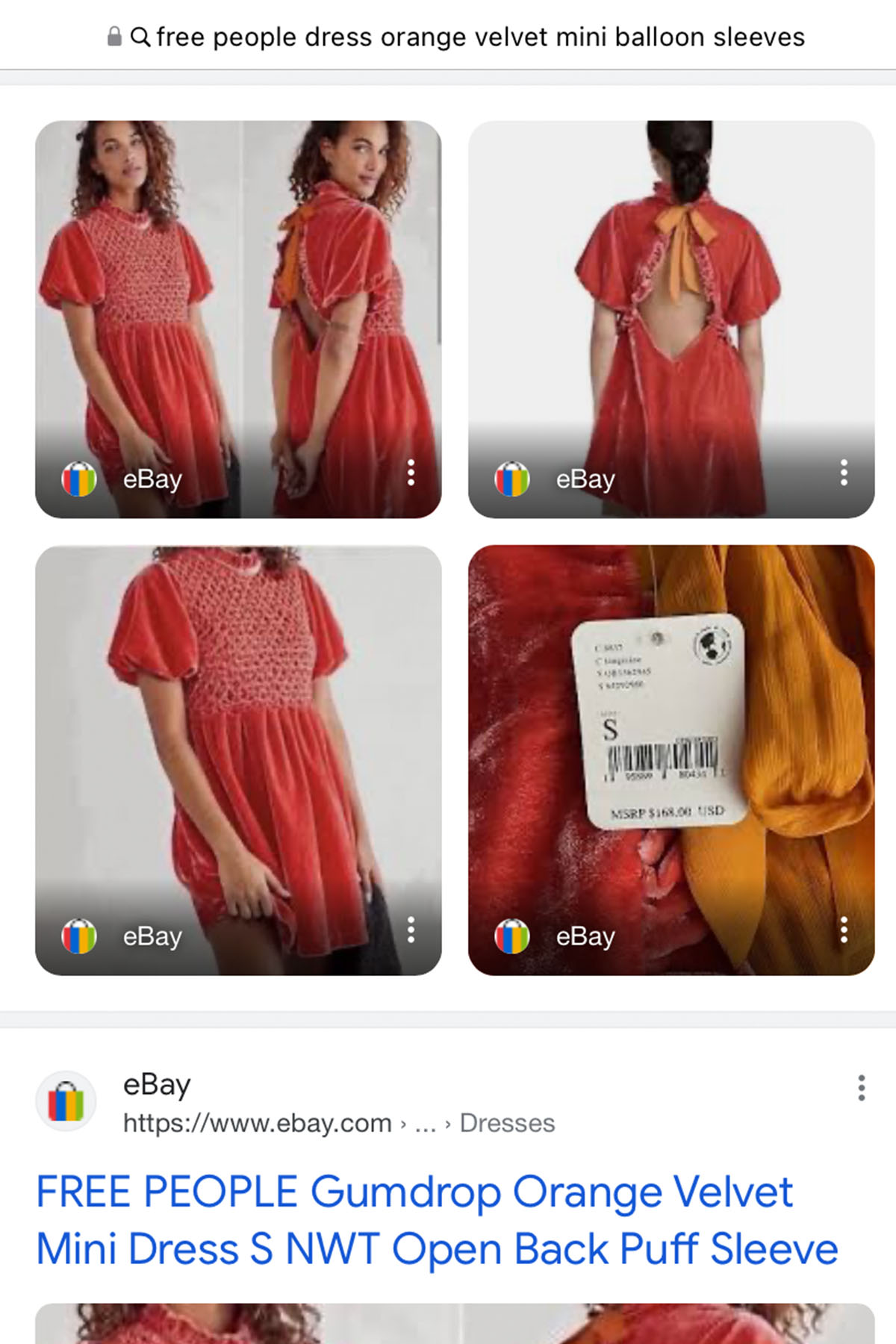
By doing that, I was able to find that my dress is the Free People Gumdrop dress. We'll use this dress example for the remainder of this section.
Check Available Listings
For this step of learning how to price on Poshmark, I went to Poshmark and searched for the Free People Gumdrop dress. Just search for the brand name, type of item, and style of the item.
Make sure to filter the size category to "all." During this process, check to see if the item is oversaturated in your item's size or color.
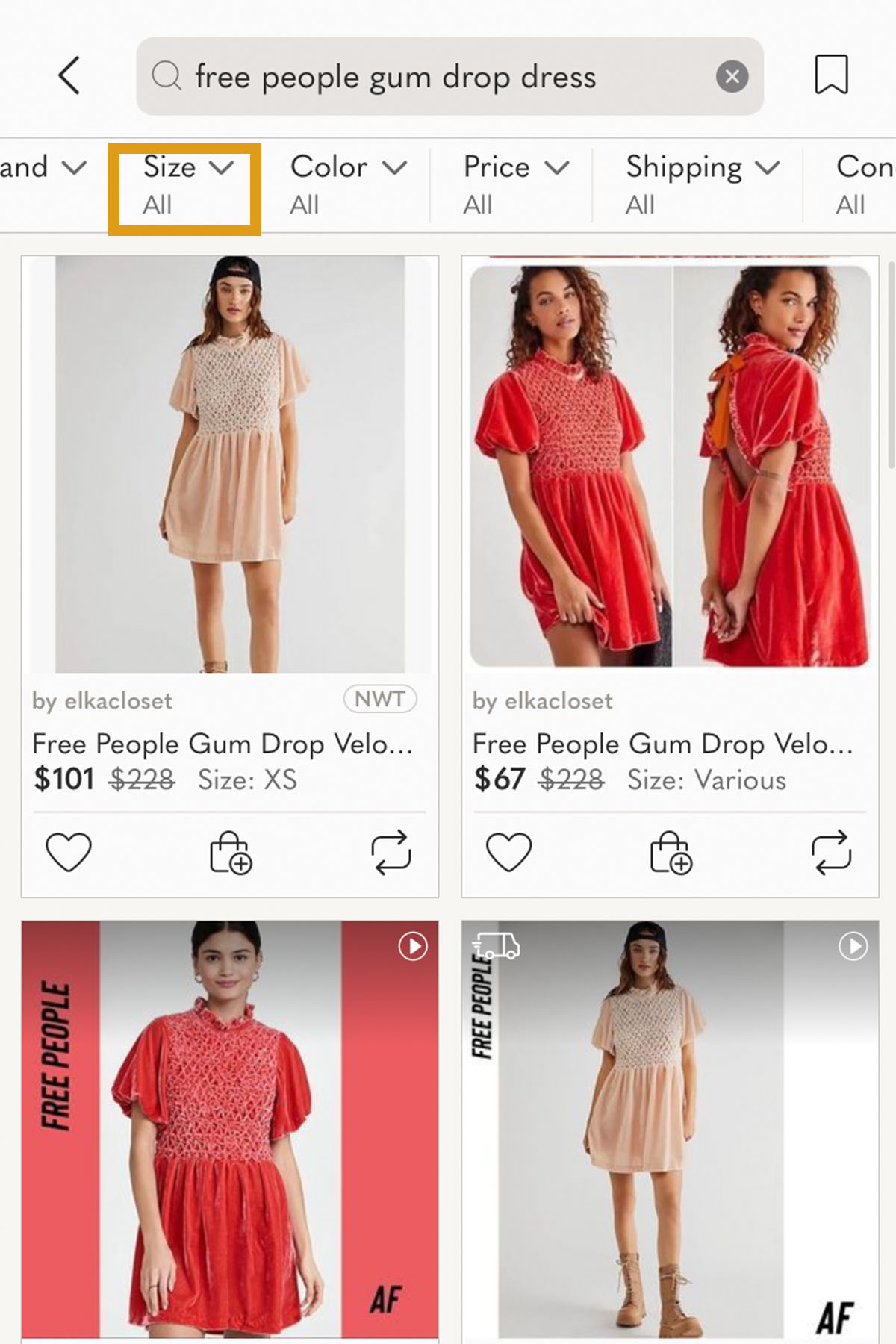
A saturated item may force you to list at a lower price to be competitive and land the sale. Or, if you’re purchasing the item at the thrift store, you may want to hold off on that purchase altogether.
Take note of the prices listed for your particular item. Specifically, pay close attention to the exact color or style of your item.
Take note of the general ballpark price range. Be sure to pay attention to the listings to see if items are new with tags or not, because this may greatly affect your pricing.
The idea is to compare apples to apples, not apples to oranges. To get the most accurate results, try to filter through and compare the same brand, color, style, and condition.
Check Sold Listings
Next, filter to the “sold” category to see what price the item has sold at historically. This is the most important piece in pricing strategy.
You may see many available listings with a price of $60, but the item may be consistently selling for $30. That means it is much more realistic that you will be able to sell for the $30 price tag.
As you can see with my Free People Gumdrop dress example, available listings were in the low $100 range. Sold items are mostly significantly less.
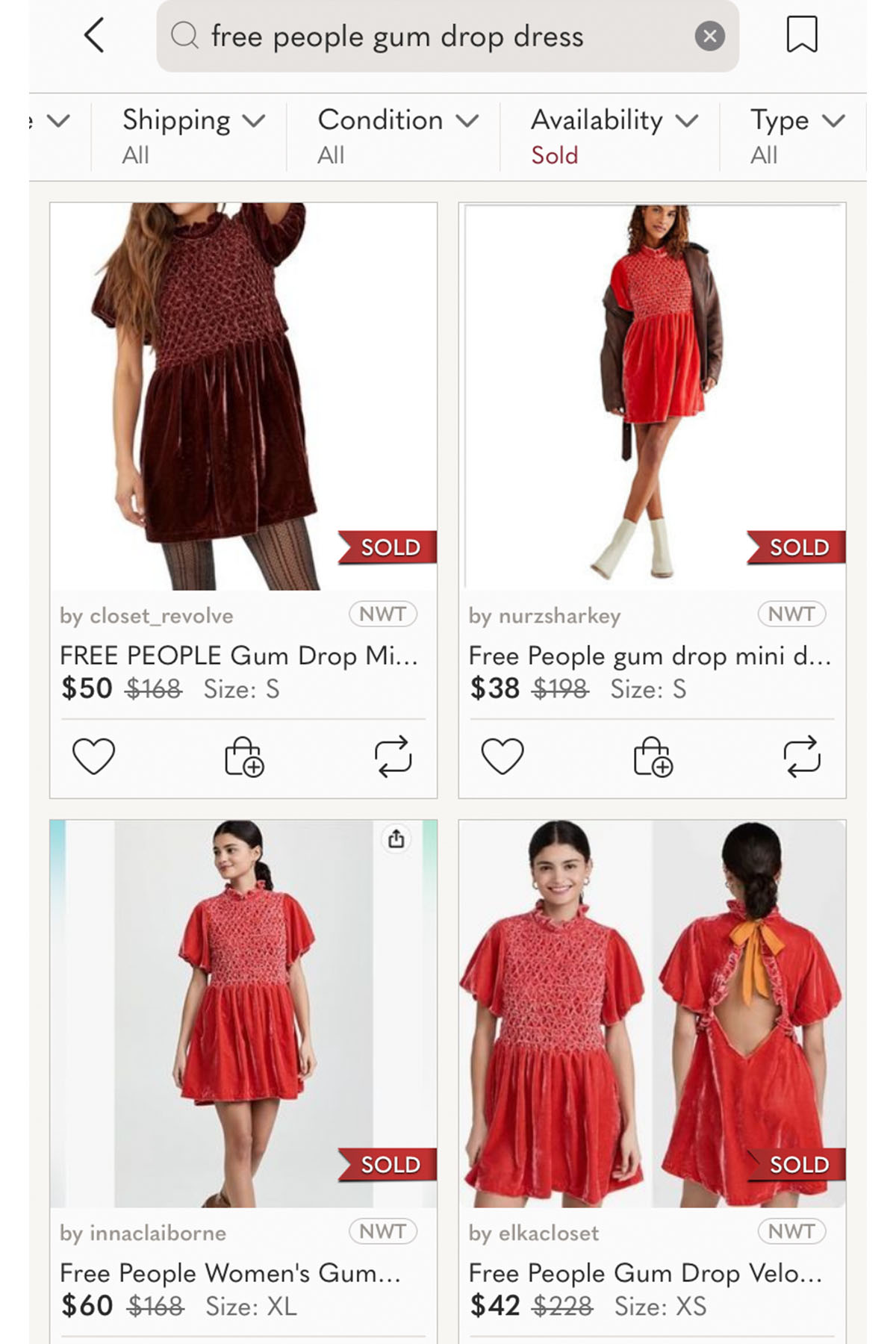
Profit Margin
The second step in pricing items on Poshmark involves running some numbers. This is an effort to ensure the item will be profitable to you while also being competitive in the marketplaces.
Determining Your Profit Margin
When it comes to calculating a goal profit margin, you will want to have an idea in your head about what you would like to profit per item. For high-volume resellers, this may be $5-$10 per item.
For low-volume, designer, or luxury resellers, you may be wanting a profit margin of $40+ per item. Neither way is right or wrong.
Many resellers have success with high-volume reselling and make a decent amount of money each month. Alternatively, some sellers focus on sourcing a small number of items that offer high-value sales.
However, this is not to say that your sourcing strategy and profit margin goal cannot change over time. Personally, I started out scouring the thrift stores and being first in line at Plato's Closet sale days, racking up hundreds of items.
I have now morphed into a hybrid, sourcing from thrift stores while also sourcing high-dollar items online. You personally have to figure out the profit margin that works best for your business.
Calculating Your Profit Margin
The next step in learning how to price items on Poshmark is calculating your profit margin. This helps you make an informed decision about whether it is worth the time and investment to pick up an item.
In order to calculate your profit margin, you will need a few data points. First, you will need the purchase price of your item.
Second, you will need to know the Poshmark fee structure. Luckily Poshmark has an easy and predictable seller fee of 20% per sale.
Use the following equation to calculate your profit per sale:
So let's go ahead and run some numbers with my Free People Gumdrop dress example. My purchase price for the dress is $15. My goal profit is $40.
As you can see from the math equation, if I sell the dress for $69, I have met my profit margin goal. If I sell for less than $69, I won't quite meet my profit margin.
These numbers for your business can vary though, as resellers find some excellent bread-and-butter brands that can make a quick sale. These items may be worth picking up even if they sell below your profit goal because it keeps money coming in and sales traction going.
Combine Comps and Profit Margin
Now let's learn how to price items on Poshmark by bringing it all together! Following your market research and calculating your bottom line for the item, it's time to combine the two. There are generally two pricing strategies that you can follow: price high or price low.
Price High
One way to price items on Poshmark is by setting a price that is the same as or higher than other similar/identical items. This strategy is great because it allows room for the flexibility to send and receive offers.
Ideally, you would price your items 10-30% higher than what you're wanting your final sale price to be. This allows you to send offers with your Poshmark bot, like PosherVA, and negotiate with potential buyers.
If buyers pay less than the listed price, there is a psychological feel-good moment that makes them feel like they are getting a good deal. This typically leads to more sales.
However, it can be a risk to price too high. If there are other similar items within the marketplace for a better price, buyers may gravitate towards those over yours.
This may lead to your item growing stale. Although, you can still beat the competition if you create a quality listing with a great description and stellar pictures.
Plus, the good news is that if you price too high and don't get much interest, you can always relist and lower the price.
Price Low
Alternatively, you can perform your market research and decide to price lower than what is currently showing from available listings. This may lead to more interest in your item because you're beating the price of others.
Ultimately, this could lead to quicker sales and a faster return of your money. However, this may limit room for negotiation.
As we talked about earlier, buyers want to negotiate and feel like they scored a good deal. If you price low, you may not be able to enter a negotiation or stray from your listing price.
Pricing Unicorn Items
A unicorn item is a unique, one-of-a-kind item that is generally hard to find yet sought after by many. So what if you found this super unique item that you can’t find on any platform?
This will require you to do some extra research. Technically, you can set the stage for pricing because you are the only one out there.
However, it would still be beneficial to perform research on the marketplace and see if you can find what the item has sold for prior and what the item retails for to set an informed price.
Attempt to find the manufacturer's site to see what the item originally retails for and use this as a guide if you cannot find the item on any marketplace.
Pricing Items On Poshmark: Thrifting Vs Mystery Boxes
Your expected profit margin is easier to control when you are thrifting or purchasing items to sell online. That is because you can check comparable items on the spot to make an informed decision before purchasing the item.
On the other hand, you will never be quite sure what you will get when purchasing mystery boxes and wholesale inventory. However, mystery boxes and wholesale are both still great options if you have included that as a part of your reselling business!

Additionally, your profit can bend as inventory gets stale and you would just like to move the items out to make room for new and better finds. This timeline is totally up to you and your business model.
As a general rule of thumb, if the item is still hanging around after 6 months, it's time to send out some serious offers. This will clear out old, generally unwanted items to make new room for better inventory.
After all, nothing is guaranteed on the resale market - and every purchase is a learning experience! Just continue to improve your craft and your informed purchasing of inventory.
As with all aspects of resale, including learning how to price items on Poshmark, there is no one right way to do something. It all depends on the structure of your business and the guidelines you have set forth.
You have to choose the route that works best for your business model. If you’re new, experiment with the different strategies that we have discussed and see what works best.
What pricing strategies do you use for your reselling business? Comment below!


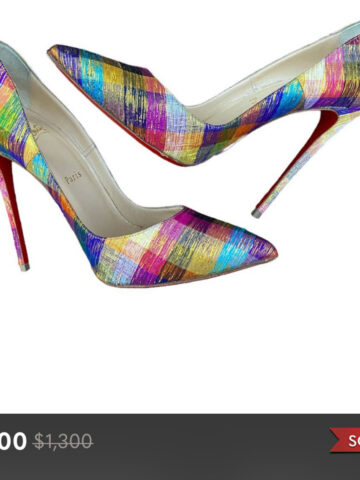
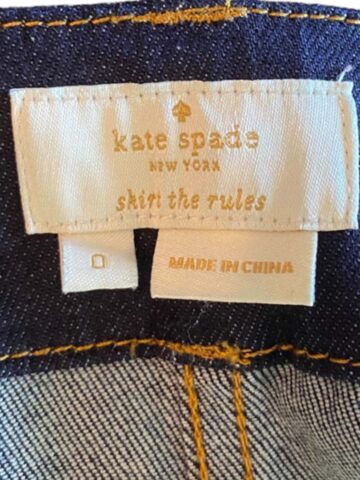

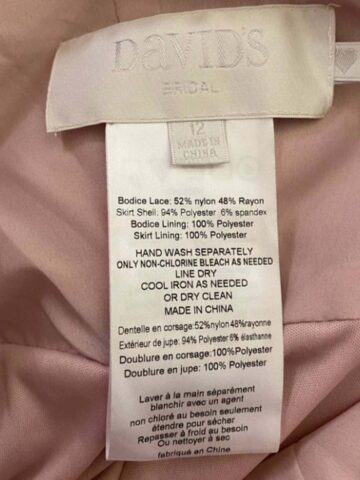
Leave a Reply